Abstract
In each blockchain network, there are different types of blocks. Although only some people know about their functions, this article will explain the various types of blocks, their characteristics, and their roles in blockchain protocols.
The types of blocks are: Orphan blocks, Stale blocks, Uncle blocks, Genesis blocks
Introduction
If we want to explain different types of blocks in a historical sort, it would be like comes below;
- Genesis Blocks: The Genesis Block is the first mined block in the bitcoin (BTC) network.
- Orphan Blocks: The hapless blocks (Miners) are those blocks miners have mined simultaneously as another block, but the blockchain ( a consensus network of nodes) does not accept them. It mainly occurs when not enough blocks are generated from that block for the network to recognize it as the longest fork.
- Stale Blocks: sometimes, we successfully mine a block. However, it does not include the current longest blockchain, which mostly happens because there already is another added block to the chain of blocks with the same height, which mainly occurs due to the network latency.
- Uncle Blocks: (So-called Aunt Blocks) sometimes, miners mine some blocks in the blockchain that do not count as a part of the main chain, which differs across various blockchains.
Orphan Blocks
The blocks we mentioned earlier in the abstract are usually related to Bitcoin. They are valid and have all the requirements, but the blockchain system rejected them for some reason. Orphan blocks are those blocks when two miners are producing the same block simultaneously, and it happens due to the acceptance of a block by nodes in a blockchain on a network.
Created blocks must be connected to nodes across the network to verify their validity, at which point a delay may occur. As a result, another miner could have created and developed the block simultaneously, which will cause a temporary gap in the network for the nodes to decide which block to continue the blockchain.
A block with better and more Consensus is the network’s chosen option to continue the blockchain’s process and work.
The network’s processing power in its construction identifies Consensus on a block. The higher the amount of this processing power, the easier for Consensus to approve that block. So, a block with less processing power is not selected, and we call them the orphan block.
Otherwise, another reason for generating Orphan Blockcs is when a hacker tries to reverse the transaction or encounters a problem.
Stale Blocks
Stale blocks are those that miners release when the network successfully approves another block, or in other words, discarded. Since mining starts with solving a mathematical problem, a miner adds the following block to the blockchain in this way.
But it is also possible that another miner will solve this mathematical problem sooner. Therefore, in this case, a miner must stop its activity on a block style and resume mining another block.

Uncle Blocks
This reward is done for two reasons:
- To promote better mining centralization, miners receive rewards for producing ankle (Uncle) blocks, which is convenient for independent miners who can receive rewards. Even if the mined block does not contain the main chain, the miner will receive the reward.
- In general, when a miner uses power to produce the “normal block” and the “uncle block”, it will increase the network’s security. As a result, the system doesn’t waste the computing power to produce the uncle block because the processing power divides to produce these two types of blocks.

Genesis Blocks
We call the first mined block of any blockchain protocol “Gensis Block.” Bitcoin’s genesis block (mother block) contains a message from its creator, ” Satoshi Nakamoto,” dated January 3, 2009, the beginning of an attempt to save the banks again. The interpretation of this message can be very diverse, but it works as a message correctly in the block that makes up the Bitcoin blockchain.
Conclusion
In conclusion, understanding the different types of blocks in a blockchain network is crucial for comprehending how the protocol operates. Orphan blocks are valid but rejected blocks that occur when two miners create a block simultaneously.
Stale blocks are discarded when the network successfully approves another block. Uncle blocks are valid blocks created by the network but are still rejected, with miners receiving a reward for producing them. Lastly, genesis blocks are the first block of any blockchain protocol and serve as the foundation for building the blockchain.
Understanding the characteristics and functions of these block types can provide insights into the workings of the blockchain protocol.
